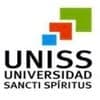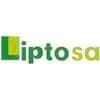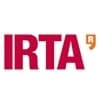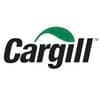Influencia de un suplemento nutricional conteniendo ácido glicirricínico sobre la presencia de hígado graso hemorrágico en ponedoras comerciales
Con el objetivo de evaluar el efecto hepatoprotector de un suplemento nutricional conteniendo ácido glicirricínico, se realizó un experimento con dos tratamientos (T1 y T2). El T1 con 8281 gallinas, recibió durante 25 días 1.5 g del suplemento nutricional por kg de concentrado, el cual estaba compuesto por maíz, soya, premezcla minero-vitamínica, carbonato de calcio y fosfato dicálcico, con un aporte de 16% de proteína bruta y 2780 kcal/kg de energía metabolizable, El T2, con 8041 gallinas, consumió solo el concentrado. Veinte días después de terminado el tratamiento, fueron trasladadas a la planta de sacrificio. Durante el examen post mórtem, fueron inspeccionados y clasificados macroscópicamente los hígados de acuerdo al grado de severidad de las lesiones en, no grasos, grasos y grasos hemorrágicos. Se tomaron fragmentos de hígado y riñón para exámenes histopatológicos. Como resultado se obtuvo en el grupo tratado 1.38% de hígados grasos hemorrágicos y 11.50% en el grupo control, valores que difirieron significativamente (p≤0.05) entre sí. Igualmente se observaron diferencias significativas con respecto a menor presencia de nefropatías, en las aves que consumieron el producto.
Palabras claves: suplemento nutricional − ponedoras− hígado graso
- Hígado no graso (sanos) el que presentaba un tamaño relativamente pequeño, superficie lisa, brillante y color rojo vino intenso e hígado no graso (con otras patologías).
- Hígado graso (HG), con una coloración más pálida y ligeramente aumentado.
- Hígado graso hemorrágico (HGH).Con lesión severa. Presentando una coloración amarillenta, tumefacto, muy frágil al tacto, superficie untuosa y en ocasiones hemorragias de diversos grados.

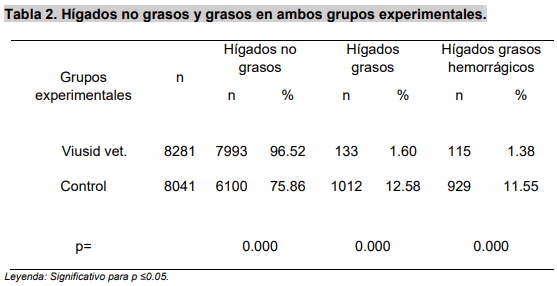
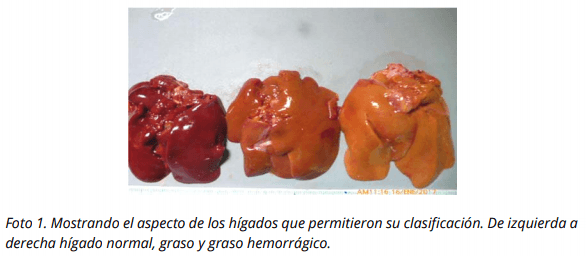
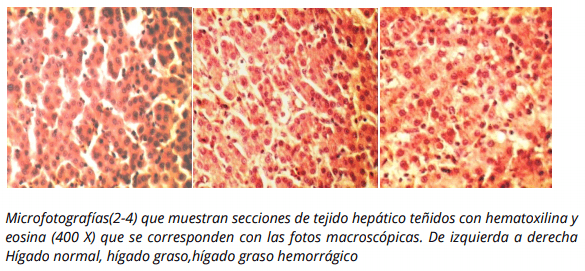
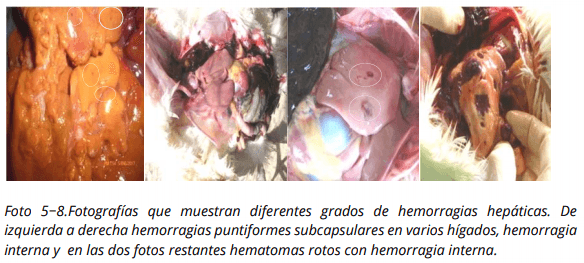

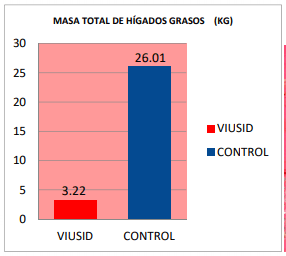
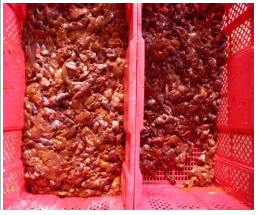
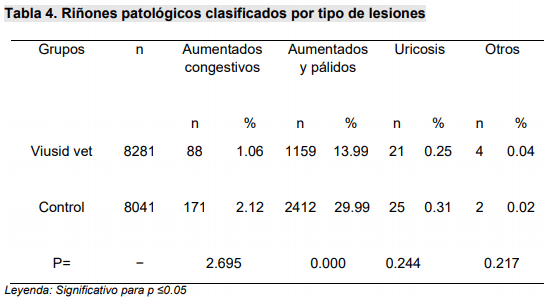
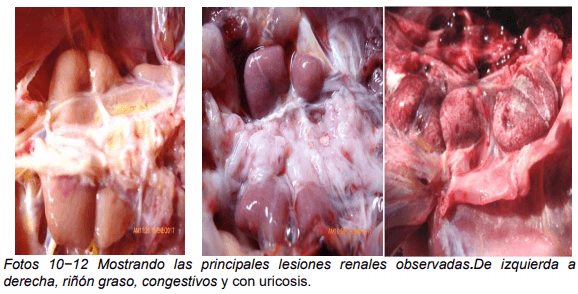
1. Abe M, Akbar F, Hasebe A, Horike N, Onji M. (2003); Glycyrrhizin enhances interleukin−10 production by liver dendritic cells in mice whit hepatitis.JGastroenterol 38: 962−967
2. Armanini, D, Nacamuli, FranciniPesenti, F (2005). Glycyrrhetinic acid, the active principle of licorice, can reduce the thickness of subcutaneous thigh fat through topical application. Steroids 70: 538–542.
3. Armanini D, Fiore C, Matterello MJ, Bielenberg J, Palermo M (2002). History of the endocrine effects of licorice. Experimental and Clinical Endocrinology & Diabetes 110: 257–261.
4. Astorga F (2012) Coste metabólico de la respuesta a la infección: el papel del hígado Selecciones avícolas. 22
5. Baskin CR, Hinchcliff KW, DiSilvestro RA, Reinhart GA, Hayek MG, Chew BP, Burr JR, Swenson RA (2000) Effects of dietary antioxidant supplementation on oxidative damage and resistance to oxidative damage during prolonged exercise in sled dogs. Am. J. Vet. Res. 61: 886-891.
6. Butler EJ (1980).El síndrome del hígado graso. y hemorrágico. (Memoria de la VI conferencia europea de avicultura 1:75-82.
7. Calero Herrera Ibrahim (2016).Evaluación del efecto del Viusid vet en terneros menores de un mes de nacidos. Taller investigaciones patrocinadas por Catalysis. Sala 4 Hotel Meliá Cohiba. Habana
8. Campabadal C. (2011). Factores nutricionales relacionados síndrome de hígado graso en Gallinas de postura. www.cuencarural.com
9. Catalysis(2014).www.catalysis.es Viusid vet
10. Cynthia MK (2005). The Merck Veterinary. Manual.9na edition. Poultry: 2226-2227
11. Cristina F, Michael E, Rea K, Eugenio R (2008). Antiviral effects of Glycyrrhiza species. Phytotherapy Research 22, 141– 148.
12. Cherian G, Goeger MP (2004). Hepatic lipid histopathology of laying hens fed CLA or n-3 fatty acids. Lipids 39(1): 31-36.
13. Contreras M (2015). Identificación de lesiones asociadas con micotoxinas en mataderos. aviNews América Latina. No. 2 septiembre.
14. Díaz-Cruz A, Serret M, Ramírez G, Ávila E, Guinzberg R, Piña E (2003) Prophylactic action of lipoic acid on oxidative stress and growth performance in broilers at risk of developing ascites syndrome. Avian Pathol. 32: 645-653.
15. Duarte TL, Lunec (2005) J. Review: When is an antioxidant not an antioxidant?A review of novel actions and reactions of vitamin C. Free Radic Res;39: 671− 676
16. Enkvetchakul B, Bottje W, Anthony N, Moore R (1993) Compromised antioxidant status associated with ascites in broilers. Poultry Sci. 72: 2272-2280.
17. Fiore C, Eisenhut M, Ragazzi E, Zanchin G, Armanini D (2005). A history of the therapeutic use of liquorice in Europe. Journal of Ethnopharmacology 99, 317–324.
18. Forn-Cuní G, Mónica V, Fernández R CM, Figueras A and Novoa B (2015). Liver immune responses to inflammatory stimuli in a dietobesity model of zebrafish. Journal of Endocrinology. DOI: 10.1530/JOE-14-0398.
19. Fraser et al., (2001). The Merck Veterinary Manual. Part VII Diseases of Poultry: 1572.
20. Guang-zhen Jiang, Wen-bin Liu , Gui-feng Li, Min Wang, XiangfeiLiG (2012) Effects of different dietary glycyrrhetinic acid (GA) levels on growth, body composition and plasma biochemical index of juvenile channel catfish, Ictalurus punctatus. Aquaculture journal homepage: www.elsevier.com/locate/aquaonline Aquaculture 338–341167– 171
21. Helmunt S (1985) Oxidative Stress. Academic Press. Londres, RU: 477
22. Kong XF, Wu GY, Liao YP, Liu HJ, Yin FG, Li TJ, Huang, RL, Zhang, YM, Deng D (2007). Effects of Chinese herbal ultra-fine powder as a dietary additive on growth performance, serum metabolites and intestinal health in earlyweaned piglets. Livestock Production Science 108, 272–275.
23. Lee CH ,Park SW, Kim YS, Kang SS, Kim JA ,Lee SH, Lee SM. (2007) Protective mechanism of glycyrrhicin on acute liver injury induced by carbon tetrachloride in mice. BiolPharm Bull; 30:1898−1904
24. López Coello C; Menocal JC, Morelia y Ávila GE (2014). Problemas de hígado graso en gallinas y pollos. conferencia VI Congreso Latinoamericano de Nutrición Animal, Brasil sitioAVÍCOLA© 2000 - 2014.
25. Luo Q, Ouyang LB, (2010). Antiobesity effect of glycyrrhizin on obese rats and its mechanism. Central South Pharmacy 8 (3), 204–208.
26. Mejía AB (2013) Hígado graso en aves comerciales: repercusiones económicas?
27. Méndez.GV (2000).Caracterización de las anemias en ponedoras White Leghorn. Causas asociadas. Rev. Cubana de Ciencia Avícola (24)1:51-58.
28. Méndez GV, Suárez ML, Rodríguez JC;,(2014). Recuperación de la coriza aviar con la aplicación de un tratamiento combinado. Revista Industria Avícola. Octubre: 18-21.
29. Méndez GV, Hidalgo de Rojas K, Ruíz RY, Suárez ML, Herrera CZ., Rodríguez JC, Cristo HM. (2016). Inmunomodulador para la enterobacteriosis en ponedoras. Rev. Ind. Avícola. Febrero: 14−17
29. MINITAB. 2003. Statistical software Minitab release 14.12.0. Pennsylvania, USA: Minitab Inc.
30. Rodriguez Fernandez JC. (2015) Effect of the nutritional supplement viusid vet on the productivity of fattening pigs in a low-input farming system. Journal of Environmental Science and Engineering B 4(11). 607- 613.doi:10.17265/2162- 5263/2015.11.005. EE.UU
31. Rodriguez Fernandez JC. (2016) Effect of the nutritional supplement Viusid vet on the productive behavior and the hemogram of replacement sows. 24th International Pig Veterinary Society Congress (IPVS) / 8th European Symposium of Porcine Health Management (ESPHM). Dublin, Ireland
32. Shimoyama Y, Sakamoto R, Akaboshi.(2001).Characterization of secretory type IIA phospholipase A2(sPLA2-IIA)as glycyrrhizin(GL)-binding protein and the GL- induced inhibition of the CK-II- mediated stimulation of sPLA2- IIA activity in vitro. Biol Pharm Bull; 24:1004-8
33. Spurlock ME, Savage JE (1993) Effect of dietary protein and selected antioxidants on fatty liver haemorrhagic syndrome induced Japanes equail.oultry Sci.72:2095-2105.
34. SPSS. 2006. Statistical Package for the Social Sciences (SPSS),versión 15.0.1. Chicago, USA: SPSS Inc.
35. Vilar Gómez E, Rodríguez MA, Gra OB,(2009);Clinical trial: a nutritional supplement Viusid, in combination with diet and exercise, in patients with nonalcoholic fatty liver disease. Aliment PharmTher 30: 999-1009.
